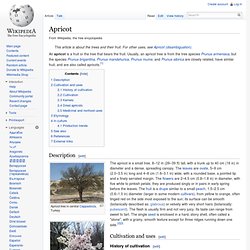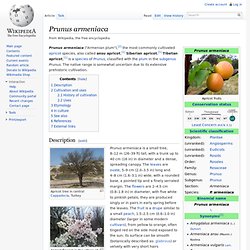

Apricot. A relative of the peach, nectarine, plum and cherry, apricots are fragrant, with a soft, velvety skin that ranges from pale yellow to deep orange.

Inside there's a large kernel that will fall out easily if the flesh is ripe. Apricots need a warm climate to thrive - in the summer most come from hot European countries, and there's also a short winter season for apricots grown in Chile and South Africa. Availability The British apricot season is from May to September. Choose the best An apricot's colour is not always a reliable guide to flavour, but steer clear of very pale varieties, and always avoid wrinkled or blemished skins.
Prepare it Halve by running a blade around the kernel following the line of the fruit's natural dimple, then gently twist apart and flip out the stone. Store it At room temperature if not completely ripe (they'll ripen in a day or two in the fruit bowl), otherwise in the fridge. Cook it Alternatives Try peach or nectarine. Prunus armeniaca. Prunus armeniaca [edit] Familia: Rosaceae Subfamilia: Amygdaloideae Tribus: Amygdaleae Genus: Prunus Subgenus: P. subg.

Prunus Sectio: P. sect. Prunus armeniaca (Apricot) Aprikose. Aprikosen Beschreibung[Bearbeiten] Die Aprikose ist ein Strauch oder kleiner Baum mit runder Krone und erreicht meist Wuchshöhen bis 6 Meter, selten auch bis 10 Meter.

Die Rinde ist glänzend und rötlich-braun. Die Rinde der Zweige ist kahl und in der Jugend rötlich. Die Langtriebe weisen keine echte Endknospe auf.[1] Die vor den Blättern erscheinenden Blüten stehen meist einzeln oder seltener in Paaren angeordnet. Die Steinfrucht besitzt einen Durchmesser von 4 bis 8 cm und ist fast kugelig und selten länglich, samtig behaart, hellgelb bis orangerot gefärbt und auf der Sonnenseite oft karminrot gefleckt oder punktiert. Die Blütezeit reicht von März bis April.[1] Die Chromosomenzahl beträgt 2n = 16.[1] Herkunft und Anbaugebiete[Bearbeiten] Die Aprikose war in Armenien schon in der Antike bekannt und wird dort schon so lange angebaut, dass häufig angenommen wird, dass dies ihre ursprüngliche Heimat sei.[2] Der botanische Name leitet sich aus dieser Annahme ab.
Apricot. An apricot is a fruit or the tree that bears the fruit.

Usually, an apricot tree is from the tree species Prunus armeniaca, but the species Prunus brigantina, Prunus mandshurica, Prunus mume, and Prunus sibirica are closely related, have similar fruit, and are also called apricots.[1] Description[edit] Apricot flowers in the village of Benhama, Kashmir The apricot is a small tree, 8–12 m (26–39 ft) tall, with a trunk up to 40 cm (16 in) in diameter and a dense, spreading canopy. The leaves are ovate, 5–9 cm (2.0–3.5 in) long and 4–8 cm (1.6–3.1 in) wide, with a rounded base, a pointed tip and a finely serrated margin.
Apricot and its cross-section. Prunus armeniaca. Prunus armeniaca ("Armenian plum"),[2] the most commonly cultivated apricot species, also called ansu apricot,[1] Siberian apricot,[1] Tibetan apricot,[1] is a species of Prunus, classified with the plum in the subgenus Prunus.

The native range is somewhat uncertain due to its extensive prehistoric cultivation. Description[edit] Apricot flowers in the village of Benhama, Kashmir Prunus armeniaca is a small tree, 8–12 m (26–39 ft) tall, with a trunk up to 40 cm (16 in) in diameter and a dense, spreading canopy. The leaves are ovate, 5–9 cm (2.0–3.5 in) long and 4–8 cm (1.6–3.1 in) wide, with a rounded base, a pointed tip and a finely serrated margin.
Apricot and its cross-section Cultivation and uses[edit] History of cultivation[edit] Apricots drying on the ground in Turkey The origin of the species is disputed. Apricots have been cultivated in Persia since antiquity, and dried ones were an important commodity on Persian trade routes. Uses[edit]